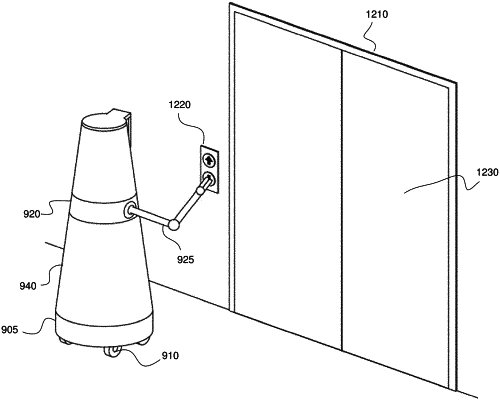| CPC B25J 9/1694 (2013.01) [B25J 9/0003 (2013.01); B25J 13/006 (2013.01); G05D 1/0094 (2013.01); G05D 1/0212 (2013.01)] | 19 Claims |

|
1. A mobile robot comprising:
a motorized base configured to move the mobile robot within an environment;
a robot body on the motorized base comprising a rotatable ring configured to rotate horizontally around the robot body and a mechanical arm extending from the rotatable ring; and
a controller configured to:
identify a location of an elevator to be used;
cause the motorized base to move to a location within a threshold distance from the elevator;
cause the mechanical arm to press a button outside of the elevator to call the elevator at least in part by rotating the rotatable ring to a first position relative to the robot body;
determine when elevator doors are open; and
responsive to determining that the elevator doors are open:
capture image data describing locations of passengers within the elevator;
responsive to determining that a target location for the mobile robot exists in the elevator:
cause the motorized base to move to the target location in the elevator at a first speed if there are passengers in the elevator and at a second speed faster than the first speed if there are not passengers in the elevator;
in response to determining that the mobile robot is closer to floor buttons inside the elevator that any of the passengers within the elevator, cause the mechanical arm to press a button inside the elevator associated with a target floor at least in part by rotating the rotatable ring to a second position relative to the robot body;
after the elevator arrives at the target floor, determine when the elevator doors are open; and
responsive to determining that the elevator doors are open at the target floor and that any passengers disembarking at the target floor have left the elevator, cause the motorized base to exit the elevator; and
responsive to determining that a target location for the mobile robot does not exist in the elevator, detecting that the elevator doors are closing and, in response to detecting that the elevator doors are fully closed, causing the mechanical arm to press the button outside the elevator a second time.
|